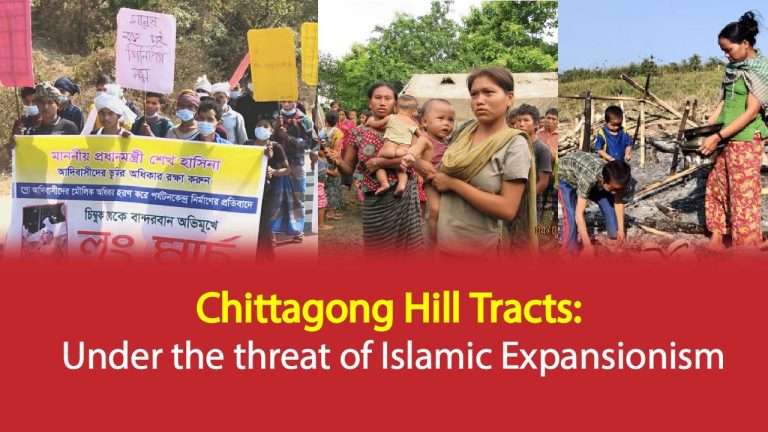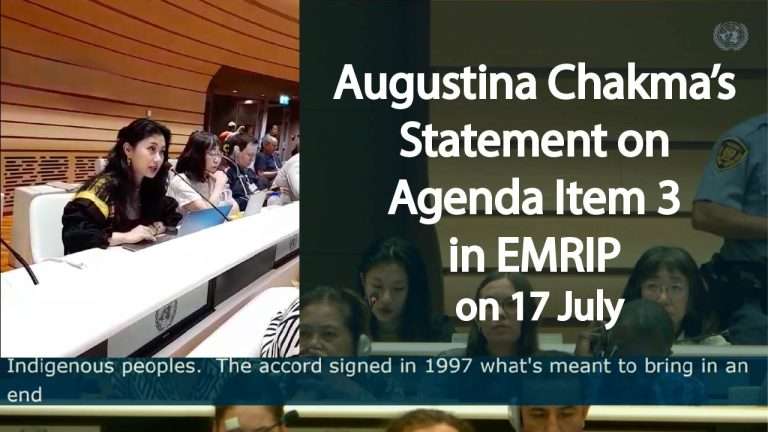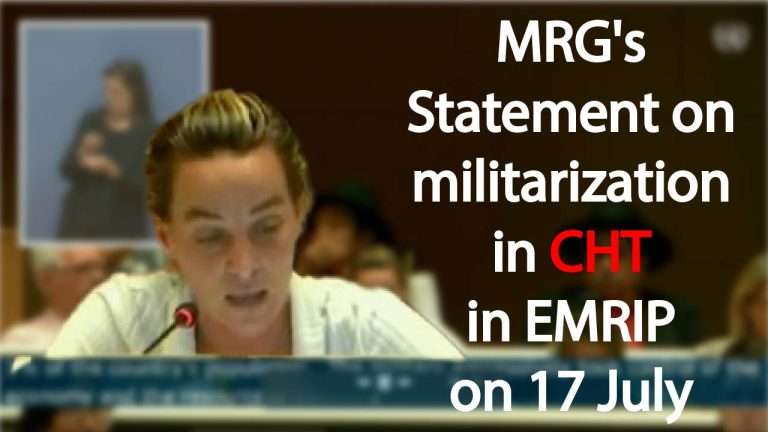Hill Voice, 11 December 2020, International Desk:Amnesty International calls on the Bangladesh authorities to fully implement its human rights provisions ofthe Chittagong Hill Tracts (CHT) Peace Accord.
Amnesty International issued this public statementtoday 11 December 2020, as December 2020 marks 23 years since CHT Accord came into effect.
The full text of the Amnesty International Public Statement is given below:
BANGLADESH: FULLY IMPLEMENT RIGHTS PROVISIONS OF THE CHITTAGONG HILL TRACTS PEACE ACCORD
December 2020 marks 23 years since the Chittagong Hill Tracts (CHT) Peace Accord came into effect. Amnesty International calls on the Bangladesh authorities to fully implement its human rights provisions.
The Peace Accord, negotiated against the backdrop of nearly two decades of armed conflict that killed thousands of people and displaced many more, was signed in 1997 between the Government of Bangladesh and the Parbatya Chattagram Jana Sanghati Samiti (PCJSS) – the political organization representing the Indigenous peoples living in the CHT region.
The CHT region is situated in the south-east of Bangladesh, bordering India and Myanmar. It comprises three hill districts of Rangamati, Bandarban and Khagrachari, with a total area of 13,294 square kilometres and an estimated population of 1.6 million. Nearly half of the population is from Indigenous peoples, while the rest is predominantly from the Bengali ethnic group. The region historically enjoyed the status of a special administrative area since the time of British rule in India. The Chittagong Hill Tracts Regulation of 1900, Government of India Act of 1919, the Government of India Act of 1935, and the Constitutions of Pakistan of 1956 and 1962 recognized the region as a specially administered area. In 1961, the then Pakistan government curtailed the traditional land rights of Indigenous peoples for the first time by amending section 34 of the 1900 Regulation. In 1962, the Pakistan government changed the status of the region to “Tribal Area”.
After the independence of Bangladesh in 1971, the new constitution failed to preserve the special status that the CHT region historically enjoyed since the British rule in India. The post-1975 governments then attempted to change the demographic character of the region by resettling Bengali people. Between 1979 and 1985, nearly 400,000 Bengali people were resettled in the CHT, fuelling an ethnic conflict that killed and displaced hundreds of thousands of Indigenous peoples, many of whom found refuge in neighbouring India.
Since the signing of the Peace Accord in 1997, Amnesty International has been monitoring the progress of its implementation. In 2000, we expressed concern over the slow pace of implementation. In 2013, we presented a detailed account of how the promises for a series of reforms regarding regional autonomy and the cultural, economic, social, civil and political rights of Indigenous peoples in the CHT region remained unfulfilled.
The status of the implementation of the Accord and the human rights situation in the CHT region remains depressingly similar to 2013. According to the PCJSS, only 15 percent of the provisions outlined in the Peace Accord have been fully implemented by the government, while more than 50 percent of the provisions remain unimplemented, and a quarter are either partially implemented or have seen some progress. The government has an entirely different take on the situation, claiming that none of the key provisions remain unimplemented, that it has fully implemented 56 percent of the provisions, and that the remaining 44 percent are either partially implemented, or in progress. Amnesty International takes the opportunity of this anniversary to highlight the status of key provisions, based on a review of relevant provisions and interviews with four experts and human rights activists working on the CHT.
The Chittagong Hill Tracts Peace Accord 1997 broadly covers three aspects: (A) protecting the characteristics of the Indigenous inhabited region; (B) empowering the CHT local government bodies; and (C) rehabilitation. The following sections review some of the human rights aspects of the Accord, and assess the progress of their implementation.
(A) PROTECTING THE CHARACTERISTICS OF THE TRIBAL INHABITED REGION
Part I of the Peace Accord forms the basis of the agreement. There are four Sections to it. Section 1 emphasizes the need to protect the characteristics of the tribal inhabited region. Section 2 outlines the responsibilities of the parties to realize this objective by making new laws, rules and regulations and amending existing relevant laws. Section 3 provides an implementation mechanism by establishing the CHT Accord Implementation Monitoring Committee, while the fourth section provides the timeline for implementation. According to the government, all four sections have been fully implemented, while the PCJSS argues that none has been fully implemented.
The key human rights concern in Part I is the cultural rights of the Indigenous peoples, which includes, inter alia, the preservation of the Indigenous nature of the region. Article 1 of both the International Covenant on Economic, Social and Cultural Rights (ICESCR) and the International Covenant on Civil and Political Rights – to both of which Bangladesh is a state party – provides that, all peoples have the right to “freely determine their political status and freely pursue their economic, social and cultural development.”
While the government has enacted and amended laws and formed the CHT Accord Implementation Monitoring Committee, the changes have had little impact on the ground in the absence of a constitutional framework acknowledging the special status of the region, framing the rules of business for the amended Acts, and the amendment of the Police Act 1861 and the CHT Regulation 1900.
The Peace Accord recognizes the need for the protection of the characteristics of the CHT as an Indigenous inhabited region. Systematic resettlement activities by successive Bangladesh governments since late 1970s have fundamentally altered the demographic character of the region and turned the Indigenous population into a minority. The Accord reiterates the determination of the signing parties to make necessary legal changes, such as amending three Hill District Council Acts of 1989 and the CHT Regional Council Act 1989; creating new legal frameworks for land disputes and for the formation of the CHT Accord Implementation Monitoring Committee.
At least five relevant legal and constitutional amendments have been implemented as per the Peace Accord. In the 15th amendment of the Constitution (Article 23a) adopted in 2011, the government included provisions for the preservation and development of language and culture of Indigenous peoples. However, the PCJSS and other CHT regional political parties demanded the amendment of Article 28(4) to make specific reference to the Indigenous peoples of the CHT region. This article provides a legal window for the government to enact special laws targeting “backward section of citizens” without violating the constitutional principle of non-discrimination. Article 28 of the Bangladesh Constitution obligates the State to “Not discriminate against any citizen on grounds only of religion, race, caste, sex or place of birth” but Article 28(4) stipulates that, “Nothing in this article shall prevent the State from making special provision in favour of women or children or for the advancement of any backward section of citizens.” The Indigenous peoples have long demanded to add a specific reference, “or the hill people of Chittagong Hill Tracts”. Amnesty International considers this proposed amendment would be an important step towards realizing the special status for the CHT region. The implementation of provisions of the Peace Accord such as the amendment of CHT Regulation 1900, the Police Act 1861, the amended CHT Regional Council Act 1998, and Hill District Council Acts 1998 are contingent upon such provision in the Constitution. Otherwise, any special status accorded to the region is vulnerable to legal challenges.
The government has also undertaken several legislative initiatives, such as the enactment of Chittagong Hill Tracts Regional Council Act 1998, the Hill District Local Government Council (HDLGC) (amendment) Act of 1998, the Chittagong Hill Tracts Land Disputes Resolution Commission Act 2001 (amended in 2016), and the Chittagong Hill Tracts Regulation (amendment) Act 2003. However, these Acts cannot be enforced in the absence of rules and regulations. Without rules of business, the Land Dispute Resolution Commission and the CHT Accord Implementation Monitoring Committee have been rendered ineffective.
(B) EMPOWERING THE CHT LOCAL GOVERNMENT BODIES
Empowering the CHT Regional Council and the Hill District Local Government Councils through the amendment of four pieces of legislation, three Hill District Local Government Council (HDLGC) Acts 1989 (Acts XIX, XX and XXI of 1989), and the CHT Regional Council Act 1989, was the largest segment of the Peace Accord. Before it was signed, the CHT region was administered by the 1989 Acts, and during the negotiation, the Indigenous leaders demanded thorough revisions of these laws. Part III of the Peace Accord aims to empower the CHT Regional Council as an independent coordinating body of the three Hill District Local Government Councils, while Part II provides for independent local government bodies in three hill districts.
In Part II, there are 35 sections providing a detail outline of the changes to be made to the 1989 Acts. While the government claims that 24 have been fully implemented, and 11 are either partially implemented or are in progress, the PCJSS argues that only 16 out of 35 have been implemented.
Part II and III concerns the government’s commitment to respect, protect, and fulfil the right of the Indigenous peoples to self-determination, the right to participate in governance and decisions that affect them, and the right of the Indigenous peoples over their traditional land. Article 1(1) of both the ICESCR and the ICCPR, to which Bangladesh is a state party, provide for the right of all peoples to self-determination, and state that, “By virtue of that right they freely determine their political status and freely pursue their economic, social and cultural development.” According to Article 25(a) of the ICCPR, every citizen has the right “to take part in the conduct of public affairs, directly or through freely chosen representatives.” The rights of Indigenous peoples over their traditional land has been acknowledged by the UN Declaration on the Rights of Indigenous Peoples, which states that governments shall consult with them “in order to obtain their free and informed consent prior to the approval of any project affecting their lands or territories and other resources.”
The Peace Accord includes reference and enabling provisions for these rights. Section 3 of Part II defines “nontribal permanent resident” as someone who is not from Indigenous community, possesses land legally in the CHT, and generally lives at a certain address in the CHT region. The provision has defined the scope of non- Indigenous permanent residency and vested the authority of this determination to the elected Indigenous leaders. According to one activist, 12 the provision has been interpreted within the CHT as establishing the authority of Indigenous leaders on local matters and to restrict further resettlement activities.
However, a government order in 2000 allowing a Deputy Commissioner (DC) to issue “Permanent Resident Certificates” vitiated this provision. It negates the authority vested on the Circle Chief – an Indigenous administrator – as per Section 4(d) of Part II. Additionally, the certificates issued by the DC would confer rights to be enrolled in the electoral roll (as per Section 9 of Part II) or enjoy other benefits meant for the Indigenous peoples and permanent residents, thereby undermining the authority of the local councils. For this reason, CHT regional political groups have long been demanding to return the power of issuing residency certificates to the Circle Chief. The government promised to amend the law, but has taken no follow-up action.
According to Section 4 of Part II, the government shall reserve three seats for women in every Hill District Council and at least one seat for the non-Indigenous peoples. While the law has been amended accordingly, the government has not organized any elections in the CHT since the signing of the Peace Accord, so the provision has remained unfulfilled in practice.
Section 26 of Part II restricts transactions involving the traditional land of the Indigenous peoples without prior permission of the Hill District Councils. Section 26(b) stipulates that, “Notwithstanding anything contained in any other law for the time being in force, no land, hill or forest under the controlled and within the jurisdiction of the Council shall be acquired or transferred by the Government without consultation with or the consent of the Council [Hill District Councils].” In addition, Section 34(a) of Part II vested the authority of “land and land management” to the Hill District Councils, while Section 27 vests the authority of land development tax collection in the Councils. These provisions are an important recognition of Indigenous peoples’ rights over their traditional land. According to the requirement of the Peace Accord, the government has amended the Hill District Council Acts 1989to include these provisions. However, since the government has not formulated the necessary rules and regulations to execute the law, DCs continue to exercise the authority of land management, including processing land mutation, acquisition, lease, and settlement, and collecting land development taxes, without consulting the Hill District Councils.
As per Section 19 of Part II, the amended 1989 Acts empowered the Hill District Councils to “formulate, initiate, and implement” development projects in the CHT region. In reality, however, the final authority on any development activities remains in the hands of CHT Affairs Ministry, which is controlled by the central government. The government has also created a parallel development agency – the CHT Development Board– which enables the Hill District Councils to be bypassed. These measures have defeated the purpose of Section 19.
In order to empower the Hill District Councils, as per Section 34 of Part II and the amended Acts of 1998, the government is supposed to transfer authority over 33 functions to the Councils, including the land management, police, Indigenous law, youth welfare, environmental protection, and local tourism, among others. To date, only 17 functions have been transferred, excluding critical functions like police and law enforcement, land and land management, and environmental protections.
In Part III, there are 14 sections outlining different amendments required to be made under the CHT Regional Council Act 1989.The government has amended different provisions of the CHT Regional Council Act in 1998. Like other sections, the government and the PCJSS have a different take on the implementation of Part III provisions. According to the government, six sections have been fully implemented, while those remaining are either partially implemented or in progress. The PCJSS on the other hand argues that only four sections have been implemented, six partially implemented, and the remaining four not implemented. The key human rights concern in Part III, like Part II, is the right to self-determination of the Indigenous peoples – largely in the form of self-government and autonomy for which the Peace Accord provided the broad framework.
The Peace Accord and the subsequent amendments in the law vest authority in the CHT Regional Council over the coordination of development activities, the amendments of the Chittagong Hill Tracts Regulation 1900, and the provision of consulting the CHT Regional Council in making any new legislation related to the region. Section 9 of Part III stipulates that, the CHT Regional Council “shall coordinate all the development activities carried out by the three Hill District Councils, and the law and order, inter alia.17 However, instead of discharging “the assigned duties” of the CHT Development Board to the CHT Regional Council, by amending CHT Development Board Ordinance 1976, the government has rather enacted new legislation, the CHT Development Board Act 2014, which allows the CHT Development Board to continue its work bypassing the local government bodies.
(C) REHABILITATION
Part IV of the Peace Accord is aimed at restoring normalcy in the CHT region by rehabilitating people displaced by the conflict, settling disputes over lands, and offering general amnesty to those who were engaged in the armed conflict. There are 19 sections that lay out the procedures for achieving these objectives. The government claims 12 sections have been fully implemented while the remaining sections are either partially implemented or have made some progress. The PCJSS finds eight of 19 sections remain unimplemented, seven implemented and the remaining four partially implemented. Part IV includes the resolution of land disputes and the provisions of positive discrimination for the Indigenous peoples by reserving job and higher education quotas.
Section 4, Part IV provides for the establishment of a Land Commission with a mandate to settle land disputes, including the authority to cancel the leases of land given to non-Indigenous and non-local peoples. As per Section 5 of Part IV of the Accord, the first Land Commission was formed in 1999 (to date, reconstituted five times). The government passed the CHT Land Disputes Resolution Commission Act in 2001, amended in 2016. However, as per Section 18 of the Commission Act, the government has yet to frame the rules of business necessary to make the Commission effective. The Commission has also not set up its offices in three hill districts and is yet to recruit any staff. Currently, 22,866 applications on land disputes remain unaddressed and not a single case has been resolved. The Commission is yet to start hearing any of the disputes in the absence of the rules.
Section 10 of Part IV of the Accord provides for the reservation of quotas for the Indigenous peoples in jobs and higher education scholarships. The government has accordingly made provisions for the Indigenous peoples across class I-IV of the government services and in higher education institutions. In 2018, however, the government scrapped the quota allocated for the Indigenous peoples in the class I and class II government jobs. International human rights laws provide for such affirmative action in favour of disadvantaged groups. The International Covenant on the Elimination of Racial Discrimination (ICERD), to which Bangladesh is a state party, allows the States to adopt temporary “special measures” to advance “effective equality” and “to secure to disadvantaged groups the full and equal enjoyment of human rights and fundamental freedoms”.
RECOMMENDATIONS
In order to make meaningful progress towards implementing the human rights provisions of the Peace Accord, Amnesty International calls on the Government of Bangladesh to:
- Propose an amendment to Article 28(4) of Bangladesh Constitution to enable specific legislation to be passed to implement the rights of Indigenous peoples.
- Preserve and protect the cultural rights of the Indigenous peoples living in the CHT region.
- Protect the rights of the Indigenous peoples over their traditional land.
- Respect, protect, and fulfil the Indigenous peoples’ right to participate in public life, and in the making of decisions that affect them.
- Take immediate and necessary measures to resolve land disputes and provide remedies to the Indigenous peoples awaiting justice for decades.
- Adopt special measures, including reinstating quotas in jobs and higher education scholarships, for the Indigenous peoples to achieve effective equality and to secure their full and equal enjoyment of human rights and fundamental freedoms.
























